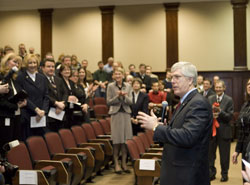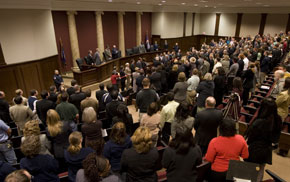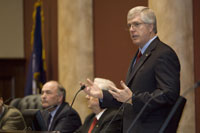Friday, April 24, 2009
Thu, 08 Mar 2007
 The long anticipated unveiling of the Supreme Courtroom at Liberty University School of Law became a reality on March 6, when it was dedicated during the annual meeting of the Board of Trustees. The beauty of the Supreme Courtroom is stunning with its one-of-a-kind design and state-of-the-art functionality.
The long anticipated unveiling of the Supreme Courtroom at Liberty University School of Law became a reality on March 6, when it was dedicated during the annual meeting of the Board of Trustees. The beauty of the Supreme Courtroom is stunning with its one-of-a-kind design and state-of-the-art functionality.
The university Provost, Dr. Boyd Rist, opened the ribbon cutting ceremony with prayer. Dr. Jerry Falwell, Liberty University’s Founder and Chancellor, addressed the crowd gathered for the historic event. In his opening remarks, Dean Mathew D. Staver commented that the Supreme Courtroom reflects the supreme vision of the School of Law. Dr. Falwell then offered the dedicatory prayer, and the ribbon was cut in the presence of a cheering crowd.
Initially called the Ceremonial Courtroom, the name was changed to the Supreme Courtroom prior to the dedication ceremony to reflect its unique design and purpose. The central feature of the Supreme Courtroom is that it is patterned after the United States Supreme Court. The actual schematic blueprints of the interior chambers of the U.S. Supreme Court were obtained from the clerk of the High Court and used in the construction and design of the this unique facility.
In order to replicate the experience of appearing before the U.S. Supreme Court, Dean Staver and Dave Morgan, head of the university’s cabinet shop, flew to Washington, D.C., where they had the rare opportunity to inspect up close the construction of the nine-member bench and other features inside the Court’s chambers that are not available to the general public.
The bench for nine Justices, the angles, the seventeen-inch elevation of the bench from the floor, and the distance of the bench from the podium are exact. The four large Roman columns behind the bench reflect the same four columns  behind the U.S. Supreme Court’s bench. When you stand at the podium in the law school’s Supreme Courtroom, you experience that unique feeling of arguing before the High Court.
behind the U.S. Supreme Court’s bench. When you stand at the podium in the law school’s Supreme Courtroom, you experience that unique feeling of arguing before the High Court.
Aside from its importance and history, arguing a case at the U.S. Supreme Court is distinctly different than at any other court in the country. In the typical federal court of appeals, there are three judges. In some state supreme courts, there might be five or even seven, but at the Supreme Court there are nine justices. The distance between the podium and the nine-member bench, compared to other courts, is much closer. The close proximity, combined with the curved bench, places the attorney right in the center of the action to respond to the rapid-fire series of questions from one side of the bench to the other.
At 4,395 square feet, the interior chamber of the law school’s Supreme Courtroom is larger than the interior of the Supreme Court. However, both courtrooms have the exact same seating capacity for the general public at 330. The Supreme Court has 250 general public seats and another 80 seats for general public attorneys who are admitted to practice before the Court. The Supreme Court has an additional 70 seats for the law clerks and guests of the Justices and the press. Additional seating can also be added to the law school’s Supreme Courtroom for larger events.
The law school’s Supreme Courtroom employs cutting-edge AV and IT technology. Cameras at the front and back, along with two large 16-foot by 9-foot retractable screens, allow the audience to see the face of the counsel during  the argument. The SMART technology podium allows documents, PowerPoint presentations, video with audio, and the internet to be projected on the large screens. Every activity can be recorded for future viewing, training, and critiquing.
the argument. The SMART technology podium allows documents, PowerPoint presentations, video with audio, and the internet to be projected on the large screens. Every activity can be recorded for future viewing, training, and critiquing.
This venue will be used as a unique training theater where students will be trained in the art of oral advocacy through moot and trial court competitions. Future cases of Liberty Counsel that reach the High Court will be practiced here for our students to observe and learn.
The Supreme Courtroom will also be used to host real court sessions by state and federal courts of appeal. Because of its unique design, the Supreme Courtroom will also be used to reenact historic Supreme Court cases, perhaps reenacted even by some of the Supreme Court Justices themselves.
Dean Staver remarked: “When students walk into the Supreme Courtroom, it is our intention to inspire them and impel them to lift their eyes and raise their expectations to new heights. There is no question that some of our students will argue before the Supreme Court. Others will aspire to the heights of government, public policy, public interest law, education, business, private practice or missions. We are equipping them to use law as a fulcrum for good throughout the world.”
For more information about the Supreme Courtroom or Liberty University School of Law, please write law@liberty.edu or call 434-592-5300.